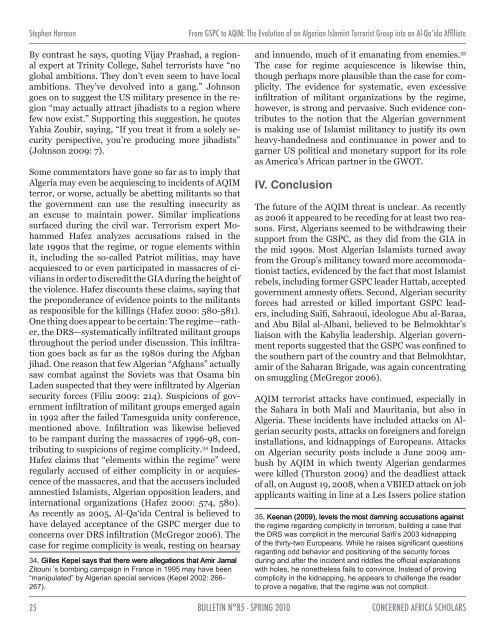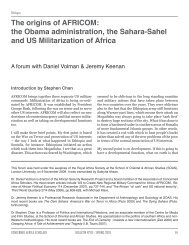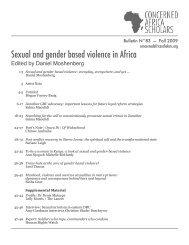Western Sahara and the United States' geographical imaginings
Western Sahara and the United States' geographical imaginings
Western Sahara and the United States' geographical imaginings
Create successful ePaper yourself
Turn your PDF publications into a flip-book with our unique Google optimized e-Paper software.
Stephen Harmon From GSPC to AQIM: The Evolution of an Algerian Islamist Terrorist Group into an Al-Qa‘ida Affiliate<br />
By contrast he says, quoting Vijay Prashad, a regional<br />
expert at Trinity College, Sahel terrorists have “no<br />
global ambitions. They don’t even seem to have local<br />
ambitions. They’ve devolved into a gang.” Johnson<br />
goes on to suggest <strong>the</strong> US military presence in <strong>the</strong> region<br />
“may actually attract jihadists to a region where<br />
few now exist.” Supporting this suggestion, he quotes<br />
Yahia Zoubir, saying, “If you treat it from a solely security<br />
perspective, you’re producing more jihadists”<br />
(Johnson 2009: 7).<br />
Some commentators have gone so far as to imply that<br />
Algeria may even be acquiescing to incidents of AQIM<br />
terror, or worse, actually be abetting militants so that<br />
<strong>the</strong> government can use <strong>the</strong> resulting insecurity as<br />
an excuse to maintain power. Similar implications<br />
surfaced during <strong>the</strong> civil war. Terrorism expert Mohammed<br />
Hafez analyzes accusations raised in <strong>the</strong><br />
late 1990s that <strong>the</strong> regime, or rogue elements within<br />
it, including <strong>the</strong> so-called Patriot militias, may have<br />
acquiesced to or even participated in massacres of civilians<br />
in order to discredit <strong>the</strong> GIA during <strong>the</strong> height of<br />
<strong>the</strong> violence. Hafez discounts <strong>the</strong>se claims, saying that<br />
<strong>the</strong> preponderance of evidence points to <strong>the</strong> militants<br />
as responsible for <strong>the</strong> killings (Hafez 2000: 580-581).<br />
One thing does appear to be certain: The regime—ra<strong>the</strong>r,<br />
<strong>the</strong> DRS—systematically infiltrated militant groups<br />
throughout <strong>the</strong> period under discussion. This infiltration<br />
goes back as far as <strong>the</strong> 1980s during <strong>the</strong> Afghan<br />
jihad. One reason that few Algerian “Afghans” actually<br />
saw combat against <strong>the</strong> Soviets was that Osama bin<br />
Laden suspected that <strong>the</strong>y were infiltrated by Algerian<br />
security forces (Filiu 2009: 214). Suspicions of government<br />
infiltration of militant groups emerged again<br />
in 1992 after <strong>the</strong> failed Tamesguida unity conference,<br />
mentioned above. Infiltration was likewise believed<br />
to be rampant during <strong>the</strong> massacres of 1996-98, contributing<br />
to suspicions of regime complicity. 34 Indeed,<br />
Hafez claims that “elements within <strong>the</strong> regime” were<br />
regularly accused of ei<strong>the</strong>r complicity in or acquiescence<br />
of <strong>the</strong> massacres, <strong>and</strong> that <strong>the</strong> accusers included<br />
amnestied Islamists, Algerian opposition leaders, <strong>and</strong><br />
international organizations (Hafez 2000: 574, 580).<br />
As recently as 2005, Al-Qa‘ida Central is believed to<br />
have delayed acceptance of <strong>the</strong> GSPC merger due to<br />
concerns over DRS infiltration (McGregor 2006). The<br />
case for regime complicity is weak, resting on hearsay<br />
3 . G������� G������� K��p��� K��p��� ���y�� ���y�� ����� ����� �������� �������� w����� w����� ������������� ������������� ����� ����� Am�� Am�� J�m�� J�m��<br />
������� ’�� b�mb��� ��mp���� �� F������ �� 995 m�y ���v�� b�����<br />
“m���p�������” by A�������� ��p������ �����v������ �K��p��� 00 : 66�<br />
6 ��.<br />
25<br />
BULLETIN N°85 - SPRING 2010<br />
<strong>and</strong> innuendo, much of it emanating from enemies. 35<br />
The case for regime acquiescence is likewise thin,<br />
though perhaps more plausible than <strong>the</strong> case for complicity.<br />
The evidence for systematic, even excessive<br />
infiltration of militant organizations by <strong>the</strong> regime,<br />
however, is strong <strong>and</strong> pervasive. Such evidence contributes<br />
to <strong>the</strong> notion that <strong>the</strong> Algerian government<br />
is making use of Islamist militancy to justify its own<br />
heavy-h<strong>and</strong>edness <strong>and</strong> continuance in power <strong>and</strong> to<br />
garner US political <strong>and</strong> monetary support for its role<br />
as America’s African partner in <strong>the</strong> GWOT.<br />
IV. Conclusion<br />
The future of <strong>the</strong> AQIM threat is unclear. As recently<br />
as 2006 it appeared to be receding for at least two reasons.<br />
First, Algerians seemed to be withdrawing <strong>the</strong>ir<br />
support from <strong>the</strong> GSPC, as <strong>the</strong>y did from <strong>the</strong> GIA in<br />
<strong>the</strong> mid 1990s. Most Algerian Islamists turned away<br />
from <strong>the</strong> Group’s militancy toward more accommodationist<br />
tactics, evidenced by <strong>the</strong> fact that most Islamist<br />
rebels, including former GSPC leader Hattab, accepted<br />
government amnesty offers. Second, Algerian security<br />
forces had arrested or killed important GSPC leaders,<br />
including Saïfi, Sahraoui, ideologue Abu al-Baraa,<br />
<strong>and</strong> Abu Bilal al-Albani, believed to be Belmokhtar’s<br />
liaison with <strong>the</strong> Kabylia leadership. Algerian government<br />
reports suggested that <strong>the</strong> GSPC was confined to<br />
<strong>the</strong> sou<strong>the</strong>rn part of <strong>the</strong> country <strong>and</strong> that Belmokhtar,<br />
amir of <strong>the</strong> <strong>Sahara</strong>n Brigade, was again concentrating<br />
on smuggling (McGregor 2006).<br />
AQIM terrorist attacks have continued, especially in<br />
<strong>the</strong> <strong>Sahara</strong> in both Mali <strong>and</strong> Mauritania, but also in<br />
Algeria. These incidents have included attacks on Algerian<br />
security posts, attacks on foreigners <strong>and</strong> foreign<br />
installations, <strong>and</strong> kidnappings of Europeans. Attacks<br />
on Algerian security posts include a June 2009 ambush<br />
by AQIM in which twenty Algerian gendarmes<br />
were killed (Thurston 2009) <strong>and</strong> <strong>the</strong> deadliest attack<br />
of all, on August 19, 2008, when a VBIED attack on job<br />
applicants waiting in line at a Les Issers police station<br />
35. . K������� K������� �� 009��, 009��, ���v����� ���v����� ����� ����� m���� m���� ��m���� ��m���� ������������� ������������� �������� ��������<br />
����� �����m�� ���������� ��mp�����y �� ����������m, b������� � ������ �����<br />
����� �RS w��� ��mp����� �� ����� m��������� S����’�� 003 k����pp���<br />
�� ����� ������y��w� E���p������. W������ ���� ��������� ������������ q�����������<br />
���������� ��� b�����v��� ��� p����������� �� ����� ���������y ��������<br />
������ ��� ������ ����� ��������� ��� ��������� ����� �������� ��xp����������<br />
w���� ��������, ���� ����������������� ������ �� ���v�����. I�������� �� p��v���<br />
��mp�����y �� ����� k����pp���, ���� �pp������ �� ������������ ����� ��������<br />
�� p��v�� � �������v��, ����� ����� �����m�� w��� ��� ��mp�����.<br />
CONCERNED AFRICA SCHOLARS




